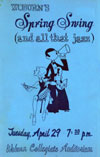Updating.... |
||
* New - Download the "Sears Festival" Award Records This plaque is awarded to productions that advance to the provincial festival. A number of Woburn Theatre productions reached this level |
 |
|
| The Drunkard | ||
Edward,
the penniless heir of his kind-hearted father, is a virtuous
man. One day the villain Squire Cribbs lures Edward to drink
in an inn, and the effect is instantaneous; he becomes a
drunkard and his poverty increases. It is his foster brother
William who finds out what Cribb is up to, discovers Edward
in the slums of London and finds the true will hidden by
the villain. |
 |
|
The
Crucible |
||
|
The
Crucible, a historical play based on events of the Salem
witchcraft trials, takes place in the small Puritan village
in the colony of Massachusetts in 1692. The witchcraft trials,
as Miller explains in a prose prologue to the play, grew
out of the particular moral system of the Puritans, which
promoted interference in others' affairs as well as a repressive
code of conduct that frowned on any diversion from norms
of behavior.
The play begins in the home of Reverend Samuel Parris, whose daughter, Betty, lays ill. Parris lives with his daughter and his seventeen-year old niece, Abigail Williams, an orphan who witnessed her parents' murder by the Indians. Parris has sent for Reverend Hale of Beverly, believing his daughter's illness stems from supernatural explanations. Betty became ill when her father discovered her dancing in the woods with Abigail, Tituba (the Parris' slave from Barbados) and several other local girls. Already there are rumors that Betty's illness is due to witchcraft, but Parris tells Abigail that he cannot admit that he found his daughter and niece dancing like heathen in the forest. Abigail says that she will admit to dancing and accept the punishment, but will not admit to witchcraft. Abigail and Parris discuss rumors about the girls: when they were dancing one of the girls was naked, and Tituba was screeching gibberish. Parris also brings up rumors that Abigail's former employer, Elizabeth Proctor, believes that Abby is immoral.... |
 |
|
Maria
Moreau and Steve Carr, in rehearsal. Peter Bortolin and
Drew Wilson in background |
||
Up
the Down Staircase |
||
The first mistake this pretty young teacher made was to
get off the bus. The second was to walk into Calvin Coolidge
High School for the first time. The third was to fall in
love with it. |
 |
|
|
|
||
David
and Lisa |
||
|
It
is the story of two teenagers, David and Lisa, who are both
in a home for mentally ill teens. David is obsessed with
clocks and has a fear of being physically touched while
Lisa can only speak in rhyme. The drama covers the powerful
bond that develops between David and Lisa. |
||
| Harvey | ||
Harvey tells the story of Elwood P. Dowd, a good natured, mild mannered eccentric who is known in all the cafeterias and saloons in his small town. Elwood is polite and cheerful and always friendly toward any strangers he might encounter, and he has just one problematic character trait: his best friend is an invisible six- foot -tall rabbit , Harvey. His sister, Veta and her daughter Myrtle try to have Elwood committed to the local sanitarium, where the behavior of the prominent psychologist and his staff raise the ageold question of who is more dangerous to society: the easy-going dreamer with a vivid imagination or the people who want him to conform to the accepted version of reality. Right
side Image - Denise Codlin and Ken Cowl |
 |
|
| The Mouse Trap | ||
"The
Mousetrap" enthralls audiences with a story about a
group of strangers stranded in a boarding house during a
snowstorm, one of whom is a murdered. The play keeps audiences
guessing as the characters realize that one of them is a
killer. |
||
| Wait
Until Dark 1981 |
Produced
& Directed by: John Wilcox & Alan Hunt Production Assistant: Karen Packer |
|
 |
Cast:
Shelley Robinson, Glenn Mullen, Andrew Bodegraven, Glenn Sumi, Scott Naylor, Mya Azevedo, Garry Graham, Kevin Bazak Susie, a recently blinded woman is unwittingly in possession of a doll filled with drugs. A very mean narcotics dealer concocts an elaborate scheme to trick her into handing it over to him. The two crooks pretend to be an old friend of Susie's husband while her husband is away and together the crooks invent a story of a |
 |
| police investigation of her husband that only the discovery of the now missing doll can save him from. Susie's blindness is the key to them searching the apartment for the doll. A great psychological thriller with a twist: the audience knows exactly what's happening but gets to watch the heroine try to figure it out on her own. It leaves us with the question, how does a blind woman defend herself? | ||
| You Can't Take It With You | ||
Alice Sycamore, the only normal person
from a zany family falls in love with her boss, Tony Kirby,
but the relation breaks up, when during a dinner at her
home, the house is raided by the police and everyone is
arrested on suspicion of anarchism. Alice
Sycamore has to introduce the family of her fiance, Tony
Kirby, to her own family. The Kirby's are wealthy, stuffy
family of great self- importance, while the Sycamore's are
a collection of good-hearted lunatics. When the two families
come together, lifestyle and philosophy collide head-on. |
 |
|
| Spring
Swing and all that Jazz |
||
 |
||
| Tribute to Broadway | ||
 |
||
